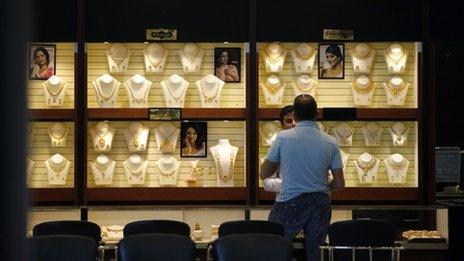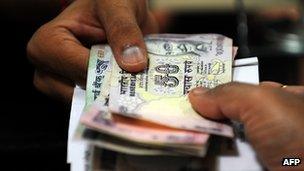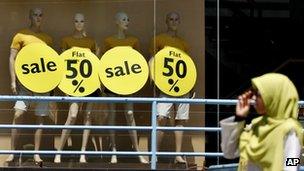How worrying is India's current account deficit?
- Published

Soaring gold imports have contributed to the deficit
What happens when a country's total imports become vastly greater than its total exports?
The country is saddled with a yawning current account deficit (CAD).
Just when it seemed that things were looking up for India's slowing economy, here comes a shocker: its CAD touched an eye-popping $33bn (£22bn) in the quarter ending December 2012, reaching a historical record level of 6.7% of gross domestic product (GDP).
A deficit is not such a bad thing when a country is growing and requires imports to fuel growth - India believes it is comfortable with a CAD which is about 2.5% of the GDP.
Anything more is a reason for concern.
'Worrying'
No wonder then that Finance Minister P Chidambaram has said that the soaring deficit is "worrying".
An increasing CAD can affect the foreign exchange rate of the country, suggesting in this case, India will have a higher demand for foreign currencies to settle its import liabilities.
This will put pressure on the rupee and weaken its value, meaning the country will need to pay more for imports.
Until about 2003, India had a more or less balanced CAD with imports matching exports.
Since then the deficit has spiralled, peaking at $33bn during the October-December quarter, up from $20bn (£13bn) during the same period the previous year.

The central bank had been under pressure to ease the burden on consumers and businesses
India is a $1.8 trillion (£1.2 trillion) economy. Imports account for a quarter of its GDP.
Inability to pay for imports can stall the economy, and a very high CAD increases risk of non-payment.
What has led to India's uncomfortably high CAD?
Basically imports are increasing and exports are unable to keep pace.
Oil accounts for 30% of India's import bill, but the country produces only 25% of its domestic requirement.
Demand for oil continues to rise in a growing economy with annual imports rising by 10% but domestic production up by only 2% over the last seven years.
The next big contributor to India's swelling import bill is gold.
India consumes a quarter of the global gold demand of 4,000 tonnes, and spends about 12% of its import bill on the metal.
Despite a doubling of import duty on the metal recently, the purchase of gold continues unabated: India imported a whopping 850 tonnes of the yellow metal in 2012.
Red tape
Exports, on the other hand, have slowed down, leading to the deficit.
Led by burgeoning info-tech revolution at home, India's export of services has grown at a rapid clip in the past decade.
But the global slowdown has hit service exports: $36bn (£23.7bn) in the last quarter, down from $37bn (£24.3bn) in the same period the previous year.
There has also been a marked decline in exports of engineering goods, textiles and iron ore.
India has financed the latest $33bn CAD by a combination of debt ($21bn) and inflows ($12bn) from foreign institutional investors (FIIs) and foreign directive investments.
FII investments are made in the stock market, and the money flows out as soon as there is a whiff of bad news. It is good to have this money, but it is not a dependable source.
So what can India do to reduce the deficit?
For one, exports needs to be bolstered.
Several solutions exist, including reducing red tape. There is also an urgent need to take quick political decisions to remove export-related regulatory bottlenecks.
For instance, exports of iron ore are suffering.

India's economy has slowed
Allegations of corruption in the allocation of iron ore mines and slow regulatory processes, including environmental clearances, have nearly crippled the industry.
In an ideal situation, either all ore available should be processed in the steel plants to enhance value added exports or a certain portion of ore should be allowed for export.
There is also a case for curbing non-productive imports like gold.
Hiking import duty has not helped much because of Indians' insatiable craving for the yellow metal.
A public awareness programme against gold consumption along with user-friendly gold bonds could help cut down on imports.
And to top it all, India needs to step up domestic energy production by pushing shale gas excavations, new oil field explorations and renewable energy sources like wind.
There is reason for hope. Exports are expected to pick up, and the market consensus is that the deficit would improve to around 5% in the current quarter. Watch this space.
Robin Banerjee has served as a senior corporate executive with several multi-nationals including Hindustan Unilever, Arcelor Mittal and Suzlon Energy
- Published7 February 2013
- Published23 January 2013
- Published12 March 2013